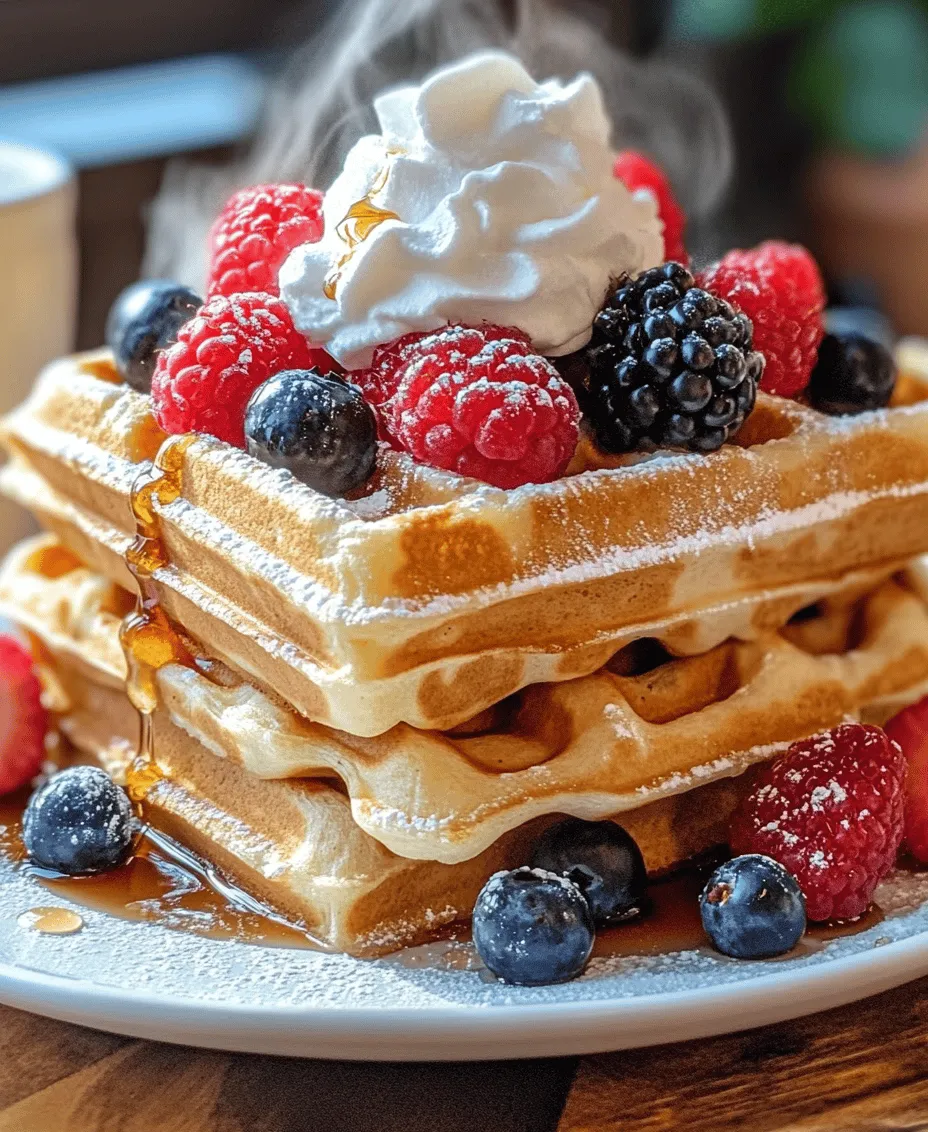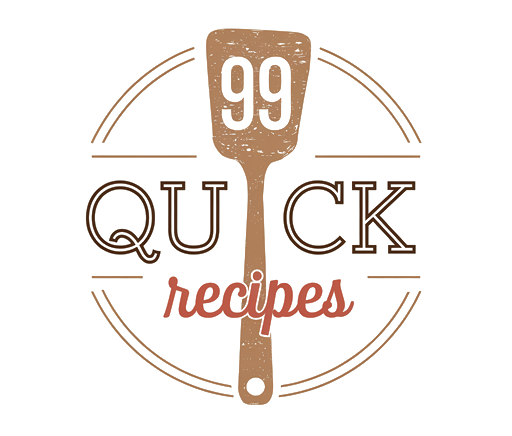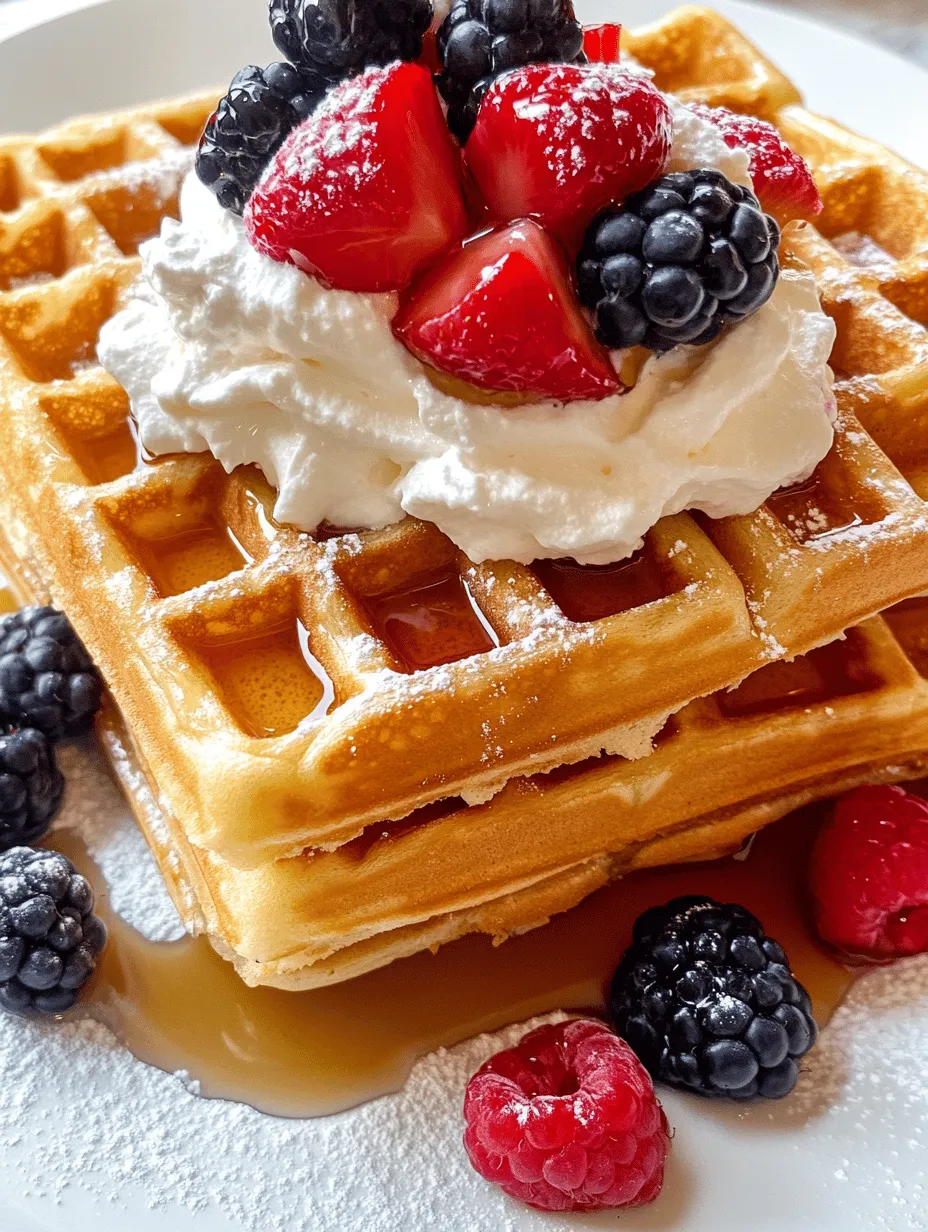Introduction
Belgian waffles have become a beloved breakfast staple around the world, renowned for their light and airy texture paired with deep pockets that hold toppings beautifully. Whether served at a local café, as a weekend treat at home, or even at festive gatherings, these waffles have secured their place in the hearts (and stomachs) of many. Their popularity is not just a result of their delightful taste, but also their versatility. From classic syrup and butter to fresh fruits, whipped cream, or even ice cream, the possibilities for customization are endless.
A good waffle recipe is essential for achieving that perfect balance of crispness on the outside and fluffiness on the inside. The joy of making waffles at home allows you to experiment with different flavors and toppings, catering to your personal preferences and dietary needs. This article will serve as a comprehensive guide to crafting fluffy Belgian waffles from scratch, ensuring that you can recreate this culinary delight in your own kitchen.
In this article, we will explore the essential ingredients that contribute to the perfect Belgian waffle, share the step-by-step preparation process, and offer serving suggestions that will elevate your waffle experience. Let’s dive into the delicious world of Belgian waffles!
Understanding the Essence of Belgian Waffles
Origin and History of Belgian Waffles
Belgian waffles trace their roots back to the Middle Ages, where they were first created in the region now known as Belgium. Originally called “Gaufres,” which is derived from the French word for honeycomb, these waffles were made using simple ingredients like flour, water, and honey, resulting in a flat and crispy treat. The modern Belgian waffle, however, gained significant popularity in the United States when it was introduced at the 1964 World’s Fair in New York by Maurice Vermersch. He showcased the waffles with a thicker batter, larger size, and deeper pockets, which helped distinguish them from their American counterparts.
As the years went by, Belgian waffles evolved, incorporating various toppings and flavors, becoming a breakfast favorite not just in Belgium but around the globe. They are now synonymous with leisure brunches and festive celebrations, often served with an array of toppings that appeal to both sweet and savory palates.
Differences Between Belgian Waffles and Other Types of Waffles
While many may think of waffles as a single entity, there are actually several types, each with its unique characteristics. Belgian waffles are distinguished by their size, texture, and the type of batter used. Here are some key differences between Belgian waffles and other types:
– Size and Shape: Belgian waffles are typically larger and thicker than traditional American waffles. They often have deeper pockets, making them ideal for holding toppings like syrup, whipped cream, and fruits.
– Batter: The batter used for Belgian waffles is often yeast-based or includes whipped egg whites, which contributes to their light and airy texture. In contrast, American waffles usually use a baking powder batter, resulting in a denser and crisper waffle.
– Texture: The texture of Belgian waffles is fluffy on the inside with a slightly crisp exterior. This contrasts with the denser and crunchier texture of American waffles.
– Serving Style: Belgian waffles are often served as a dessert or brunch item, topped with sweet ingredients, while American waffles are more commonly enjoyed as a breakfast dish, often paired with butter and maple syrup.
Characteristics of Perfect Belgian Waffles: Texture, Taste, and Appearance
The hallmark of a perfect Belgian waffle is its delicate balance of texture, taste, and visual appeal:
– Texture: The ideal Belgian waffle should be light and fluffy on the inside, with a crisp exterior that holds its shape. The pockets should be deep enough to capture syrup or toppings without overflowing.
– Taste: A well-made waffle should have a subtle sweetness that complements its toppings. The flavor should be slightly buttery with hints of vanilla, creating a delicious base for both sweet and savory toppings.
– Appearance: Belgian waffles are typically golden-brown with a visually appealing grid pattern. Their inviting appearance makes them a favorite for brunch tables and dessert platters.
Essential Ingredients for Fluffy Belgian Waffles
Crafting the perfect fluffy Belgian waffle requires a few key ingredients, each playing a vital role in the final result. Here’s a breakdown of the essential components:
– All-Purpose Flour: This is the foundation of the waffle batter. All-purpose flour provides structure and texture, allowing the waffles to rise while maintaining a delicate crumb.
– Sugar: Adding sweetness to the batter, sugar not only enhances the flavor but also contributes to the browning of the waffles, giving them that desirable golden color.
– Baking Powder: The leavening agent responsible for creating fluffiness in the waffles. Baking powder releases carbon dioxide when it interacts with moisture and heat, resulting in a light and airy texture.
– Salt: A key ingredient that enhances flavor, salt balances the sweetness and brings out the richness of other ingredients.
– Eggs: Eggs serve as a binding agent, helping to hold the batter together while also adding richness and moisture. They contribute to the overall structure of the waffle.
– Milk: Providing moisture and a smooth texture, milk helps achieve the right consistency in the batter. You can use whole milk for a richer flavor or substitute with plant-based milk for a dairy-free option.
– Unsalted Butter: Butter adds flavor and tenderness to the waffles. Using unsalted butter allows you to control the saltiness of the batter.
– Vanilla Extract: A splash of vanilla extract elevates the flavor profile, adding depth and warmth to the batter.
Optional Toppings and Their Contribution to the Overall Experience
While the base of the waffle is delicious on its own, the toppings you choose can elevate your waffle experience to new heights. Here are some popular options:
– Fresh Fruits: Strawberries, blueberries, bananas, or even peaches add a refreshing touch and natural sweetness.
– Whipped Cream: A dollop of whipped cream brings a light, airy texture that complements the waffles beautifully.
– Maple Syrup or Honey: Classic sweeteners that add rich flavor and moisture, enhancing the overall experience.
– Nuts: Chopped nuts like pecans or walnuts provide a crunchy contrast to the soft waffle texture.
– Chocolate Chips or Nutella: For those with a sweet tooth, these options add a decadent twist that’s sure to please.
– Ice Cream: Transform your waffles into a dessert by adding a scoop of ice cream on top, perfect for special occasions or a treat any time of year.
Step-by-Step Guide to Making Fluffy Belgian Waffles
Before we dive into the preparation, it is crucial to ensure that you have the right tools and equipment ready. A Belgian waffle maker is essential for achieving the characteristic shape and texture of these waffles.
Preparing the Waffle Maker: The Importance of Preheating
One of the most critical steps in making perfect Belgian waffles is preheating your waffle maker. Preheating allows the batter to cook evenly, resulting in a crisp exterior while keeping the inside fluffy. Follow the manufacturer’s instructions for your specific waffle maker to ensure optimal results. Most waffle makers will have an indicator light that signals when they’re ready to use.
Once your waffle maker is preheated, it’s time to gather your ingredients and start mixing the batter. Keep an eye out for the next part of this article, where we will provide a detailed step-by-step guide to creating the ultimate fluffy Belgian waffles, along with tips for achieving the best results.

Mixing Dry Ingredients
To achieve fluffy Belgian waffles, precise measurement and proper mixing of dry ingredients are essential. Begin by combining the flour, sugar, baking powder, baking soda, and salt in a large mixing bowl. The distribution of leavening agents like baking powder and baking soda is crucial for achieving that light, airy texture. Use a whisk to mix these dry ingredients thoroughly. Whisking not only combines them but also aerates the mixture, promoting even rising when the batter is cooked.
Make sure there are no clumps of baking powder or soda, as these can lead to unevenly risen waffles. Ensuring that your dry ingredients are well-mixed sets a strong foundation for your batter and ultimately your waffles.
Combining Wet Ingredients
Next, shift your focus to the wet ingredients. In a separate bowl, combine the eggs, buttermilk (or milk), melted butter, and vanilla extract. The key to a smooth batter lies in the temperature and consistency of your wet ingredients. If your butter is too hot, it can cook the eggs; if it’s too cold, it may clump when combined with the other ingredients.
To achieve a smooth batter, whisk the wet ingredients until they are fully blended. This should take about 30 seconds to 1 minute. If you prefer a richer flavor, consider using whole milk or adding a splash of cream. Remember to mix the wet ingredients just enough to combine; excessive mixing can lead to gluten development, resulting in dense waffles.
The Mixing Process
With your dry and wet ingredients prepared, it’s time to combine them. Pour the wet mixture into the bowl of dry ingredients. Using a spatula or wooden spoon, gently fold the batter together. The key to fluffy waffles is to avoid overmixing. Overmixing can develop gluten, leading to tough waffles instead of the intended light and airy texture.
Mix until just combined; it’s okay if there are a few lumps remaining. This gentle folding technique helps maintain the airiness of the batter. Let the batter sit for about 5 minutes. This resting period allows the flour to hydrate and the leavening agents to activate, contributing to the fluffiness of the waffles.
Greasing the Waffle Maker
Before cooking, it’s important to prepare your waffle maker properly. Preheat your waffle maker according to the manufacturer’s instructions. Once heated, lightly grease the cooking plates with a non-stick cooking spray or a small amount of melted butter. This step is crucial as it prevents the waffles from sticking, ensuring they come out easily and maintain a beautiful, golden-brown color.
If your waffle maker is non-stick, you may not need much grease, just a light coating will suffice. Avoid using too much oil, as this can make the waffles greasy.
Cooking the Waffles
Now it’s time to cook your waffles! Pour the recommended amount of batter onto the preheated waffle maker, being careful not to overfill. Close the lid and cook according to the manufacturer’s instructions, usually around 3 to 5 minutes. Timing can vary depending on your specific waffle maker, so keep an eye on the waffles as they cook.
For perfect doneness, look for steam to stop escaping from the waffle maker. This indicates that the waffles are likely done. Open the waffle maker gently and check for a golden-brown color. If they need more time, close the lid and continue cooking for an additional minute.
Serving Suggestions
Belgian waffles are incredibly versatile and can be dressed up in countless ways. Here are some creative serving suggestions to elevate your waffle experience:
The Perfect Serving Suggestions for Belgian Waffles
– Whipped Cream: Light and fluffy whipped cream is a classic topping. You can use homemade whipped cream or store-bought, adding a touch of vanilla extract for flavor.
– Fresh Berries: Top your waffles with an assortment of fresh berries like strawberries, blueberries, or raspberries. They add a burst of color and a refreshing taste that complements the sweetness of the waffles.
– Maple Syrup: A drizzle of pure maple syrup is a traditional favorite. The rich flavor of maple syrup enhances the flavor of the waffles beautifully.
– Chocolate Sauce: For chocolate lovers, drizzle warm chocolate sauce over your waffles. You can also sprinkle chocolate chips into the batter for an extra chocolatey treat.
Nutritional Considerations of Various Toppings
While toppings add delightful flavors, it’s essential to be mindful of their nutritional value. Whipped cream and chocolate sauce can significantly increase the calorie count, so consider balancing them with healthier options like fresh fruit or yogurt.
If you want to reduce sugar intake, opt for natural sweeteners like honey or agave syrup. Remember that fresh fruits not only add flavor but also provide vitamins and antioxidants, making them a nutritious choice.
Seasonal Variations for Toppings
Seasonality can also play a role in your waffle toppings. In the spring and summer, fresh fruits like peaches or cherries are delicious options. In the fall, consider topping your waffles with warm apple slices sautéed in cinnamon and sugar, or a pumpkin spice cream. Winter months could call for a hearty topping of roasted nuts or spiced cranberry compote. Experimenting with seasonal fruits and flavors can keep your waffle experience fresh and exciting throughout the year.
Exploring Variations of Belgian Waffles
Belgian waffles offer endless possibilities for customization. Here are some exciting ideas to explore:
Suggestions for Flavor Variations
Consider adding spices or extracts to your batter for an elevated flavor profile. A teaspoon of cinnamon or nutmeg can add warmth to the waffles. Almond extract, for instance, provides a lovely aroma and pairs well with fruit toppings.
Ideas for Incorporating Ingredients into the Batter
To add texture and flavor, consider mixing in ingredients such as chocolate chips, nuts, or even fruit. For a decadent treat, fold in semi-sweet or dark chocolate chips into the batter before cooking. Chopped nuts like walnuts or pecans can add a crunch, while mashed bananas or blueberries can infuse the batter with moisture and natural sweetness.
Savory Belgian Waffle Options for Brunch or Lunch
Don’t limit yourself to sweet toppings—savory Belgian waffles can be a delightful addition to brunch or lunch menus. Consider adding herbs like chives or parsley to the batter, or serve the waffles topped with poached eggs, avocado slices, and a sprinkle of cheese. You could also create a savory waffle sandwich by filling the waffles with ingredients such as smoked salmon, cream cheese, and capers.
Common Challenges and Troubleshooting Tips
Even the most seasoned home cooks encounter challenges while making waffles. Here’s how to troubleshoot common issues:
Addressing Common Issues in Waffle-Making
– Undercooked Waffles: If your waffles are undercooked, they might need more time in the waffle maker. Make sure your waffle maker is fully preheated before pouring in the batter, and always refer to the manufacturer’s cooking guidelines.
– Overcooked Waffles: If your waffles are overcooked and too dark, reduce the cooking time slightly. Every waffle maker is different, and some may require less time than others.
– Soggy Waffles: To avoid soggy waffles, ensure that your batter isn’t too runny. If you find that your batter is too thin, add a little more flour to thicken it up. Additionally, allow the waffles to cook until the steam has subsided completely before removing them from the waffle maker.
Troubleshooting Texture Problems
Achieving the perfect fluffiness in your waffles can sometimes be tricky. If your waffles are dense, check that you’re not overmixing the batter. Remember to fold the wet ingredients into the dry until just combined. Also, consider letting the batter rest for a few minutes before cooking, as this helps develop a lighter texture.
Tips for Storage and Reheating Leftover Waffles
If you have leftover waffles, store them in an airtight container in the refrigerator for up to three days. For longer storage, freeze them between layers of parchment paper in a freezer-safe bag. When you’re ready to enjoy them again, reheat in a toaster or toaster oven until crispy and warmed through.
Conclusion
Fluffy Belgian waffles are a delightful treat that can be enjoyed at any time of the day. The process of making them from scratch can be a joyful culinary experience, allowing you to experiment with flavors and toppings that suit your personal taste. Whether you enjoy them sweet with whipped cream and berries or savory with poached eggs, the possibilities are endless.
Don’t be afraid to get creative with your waffle variations and toppings, and remember that homemade breakfasts can bring a sense of warmth and happiness to any morning. Embrace the joy of cooking, and let your Belgian waffles be a canvas for your culinary creativity!

